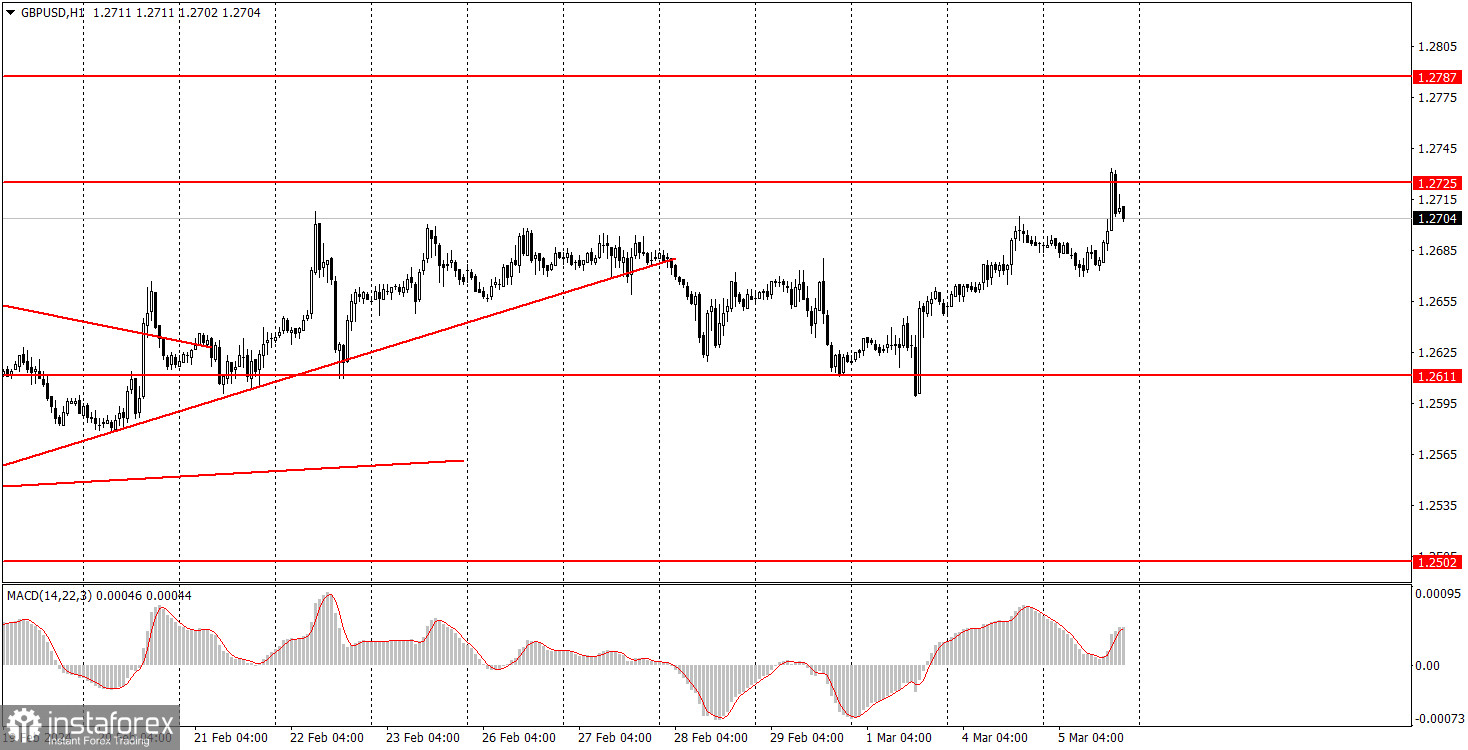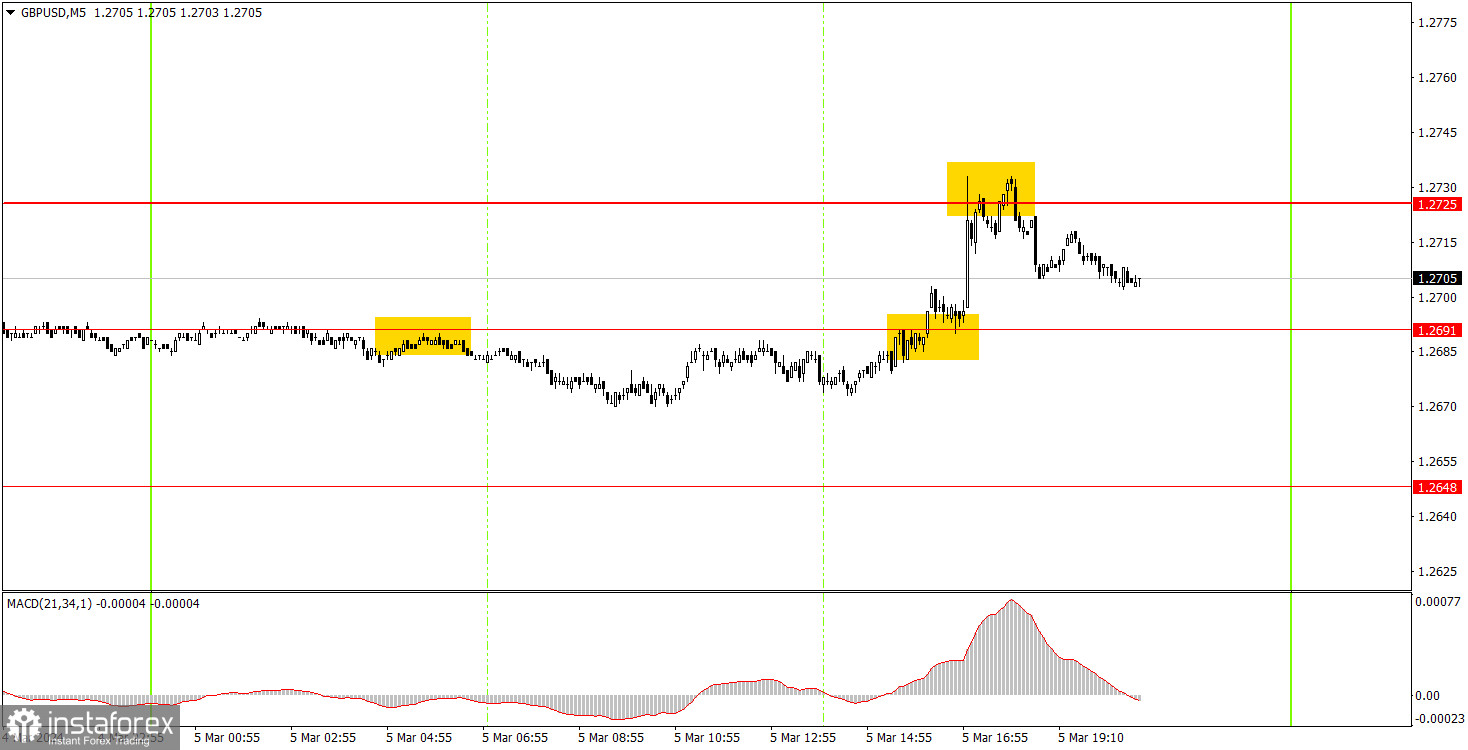Analyzing Tuesday's trades:
GBP/USD on 1H chart

GBP/USD gained ground on Tuesday, and, by the end of the day, it tested the level of 1.2725. A rebound from this level may trigger a new downward movement; however, it is worth noting that on the 24-hour timeframe, the pair remains within a global flat phase. The British pound can gradually rise up to the level of 1.2787, and the flat will persist. The only reason why the pound traded higher on Tuesday is because of the weak US ISM Services report. However, even within the flat range, the British pound didn't need any reasons to rise against the dollar. Any kind of movement doesn't need any specific reason to justify it when a pair is trading inside a sideways channel. Therefore, you can trade from the level of 1.2725 on Wednesday. A rebound suggests short positions with 1.2611 as the target. If the price surpasses this mark, you may consider long positions with a target of 1.2787.
GBP/USD on 5M chart

There were few trading signals on the 5-minute timeframe. The first sell signal was weak, and the price could not even move in the intended direction by 20 pips. The second buy signal around the same level of 1.2691 was stronger, and the ISM index helped the pair move in the intended direction. The price quickly reached the nearest target level of 1.2725, with only 25 pips needed to cover the distance. The rebound from this level made it possible for beginners to open short positions, and eventually they could have earned a small profit on this by the evening. Therefore, beginners could make around 10 pips from three trades, but volatility remains weak, so we shouldn't expect significant profit.
Trading tips on Wednesday:
On the hourly chart, GBP/USD continues to trade flat, with only the sideways channels changing. Each time frame has its own channel. We expect the pound to fall, but the market is not in a rush to sell the pound. We believe it is appropriate for you to consider short positions on the pound if the pair consolidates below the area of 1.2605-1.2611. However, a new downward movement can also start from the levels of 1.2725 and 1.2787.
The key levels on the 5M chart are 1.2270, 1.2310, 1.2372-1.2387, 1.2457, 1.2502, 1.2544, 1.2605-1.2611, 1.2648, 1.2691, 1.2725, 1.2787-1.2791, 1.2848-1.2860, 1.2913, 1.2981-1.2993. On Wednesday, the UK will release the second estimate of the Construction PMI for February. In the U.S., traders will focus on Federal Reserve Chairman Jerome Powell's speech, and important reports on JOLTs and ADP. We can expect more significant movements during the U.S. session compared to what we observe almost every day.
Basic trading rules:
1) Signal strength is determined by the time taken for its formation (either a bounce or level breach). A shorter formation time indicates a stronger signal.
2) If two or more trades around a certain level are initiated based on false signals, subsequent signals from that level should be disregarded.
3) In a flat market, any currency pair can produce multiple false signals or none at all. In any case, the flat trend is not the best condition for trading.
4) Trading activities are confined between the onset of the European session and mid-way through the U.S. session, after which all open trades should be manually closed.
5) On the 30-minute timeframe, trades based on MACD signals are only advisable amidst substantial volatility and an established trend, confirmed either by a trendline or trend channel.
6) If two levels lie closely together (ranging from 5 to 15 pips apart), they should be considered as a support or resistance zone.
How to read charts:
Support and Resistance price levels can serve as targets when buying or selling. You can place Take Profit levels near them.
Red lines represent channels or trend lines, depicting the current market trend and indicating the preferable trading direction.
The MACD(14,22,3) indicator, encompassing both the histogram and signal line, acts as an auxiliary tool and can also be used as a signal source.
Significant speeches and reports (always noted in the news calendar) can profoundly influence the price dynamics. Hence, trading during their release calls for heightened caution. It may be reasonable to exit the market to prevent abrupt price reversals against the prevailing trend.
Beginners should always remember that not every trade will yield profit. Establishing a clear strategy coupled with sound money management is the cornerstone of sustained trading success.
 English
English 
 Русский
Русский Bahasa Indonesia
Bahasa Indonesia Bahasa Malay
Bahasa Malay ไทย
ไทย Español
Español Deutsch
Deutsch Български
Български Français
Français Tiếng Việt
Tiếng Việt 中文
中文 বাংলা
বাংলা हिन्दी
हिन्दी Čeština
Čeština Українська
Українська Română
Română

